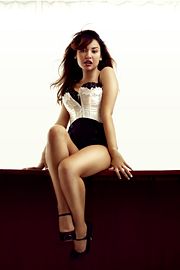Pin-up
(Remove duplication) |
(Remove irrelevant material) |
||
| Line 12: | Line 12: | ||
In recent years, illustration artists have explored pin-up in more radical ways, namely Rion Vernon, the creator of the term "pinup toons", who has merged the classic pin-up girl with the cartoon and caricature realms. | In recent years, illustration artists have explored pin-up in more radical ways, namely Rion Vernon, the creator of the term "pinup toons", who has merged the classic pin-up girl with the cartoon and caricature realms. | ||
| − | + | Female pin-ups are often depicted in sexy clothing, such as [[bikinis]], [[miniskirt]]s or [[lingerie]]. | |
| − | + | ||
| − | + | ||
| − | + | ||
==External links== | ==External links== | ||
Revision as of 14:36, 29 June 2013
A pin-up girl or pin-up model is a model whose mass-produced pictures see wide appeal as pop culture. Pin-ups are intended for informal display. Pin-up girls are often glamour models, fashion models, and actresses.
"Pin-up" may also refer to drawings, paintings and other illustrations done in emulation of these photos. The term was first attested to in English in 1941; however the practice is documented back at least to the 1890s. The "pin up" images could be cut out of magazines or newspapers, or be from postcard or chromo-lithographs, and so on. Such photos often appear on calendars, which are meant to be pinned up anyway. Later, posters of "pin-up girls" were mass-produced.
Many "pin ups" were photographs of celebrities who were considered sex symbols. One of the most popular early pin-up girls was Betty Grable. Her poster was ubiquitous in the lockers of G.I.s during World War II. Others pin-ups were artwork, often depicting idealised versions of what some thought a particularly beautiful or attractive woman should look like. An early example of the latter type was the Gibson girl, drawn by Charles Dana Gibson. The genre also gave rise to several well-known artists specializing in the field, including Alberto Vargas and George Petty, and numerous lesser artists such as Art Frahm.
The term "cheesecake" is synonymous with "pin-up photo".
These days men can be considered "pin ups" as well and there are male equivalents of attractive and sexy actors such as Brad Pitt or numerous male models. The counterpart term to "cheesecake" is "beefcake".
In recent years, illustration artists have explored pin-up in more radical ways, namely Rion Vernon, the creator of the term "pinup toons", who has merged the classic pin-up girl with the cartoon and caricature realms.
Female pin-ups are often depicted in sexy clothing, such as bikinis, miniskirts or lingerie.
External links
| This page uses content from SM-201; the original article can be viewed here. |
